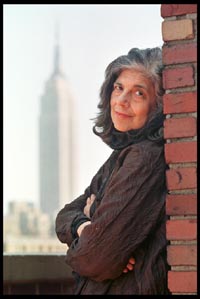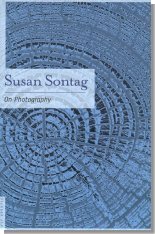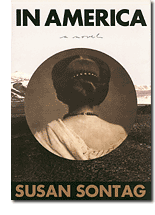

Susan Sontag Papers — View Online Finding Aid

In 2002 the UCLA Library acquired the papers of Susan Sontag, a unique record of her distinguished career in American letters. This extensive archive includes manuscripts of her writings; correspondence with contemporary writers, artists, musicians, and other intellectual and historical figures; her personal notebooks; and her private library, consisting of more than 20,000 books in all areas of literature, the arts, history and the social sciences. Sontag's oeuvre includes seven major works of nonfiction, four novels, a play, and four full-length films. One of America's best known and most influential writers, Sontag was awarded the Jerusalem Prize in 2001 for the body of her work. This prize, awarded biannually at the Jerusalem International Book Fair, is second only to the Nobel Prize for literary prestige. In addition to this award in recognition of her entire career in letters, Sontag's novel In America won the National Book Award for Fiction and her book of essays On Photography received the National Book Critics Circle Award for Criticism. In Spring 2002, exhibitions in the Powell Library Rotunda and in Library Special Collections celebrated this major acquisition by presenting an introduction to the correspondence and publications in the archive.
|

The correspondence in the Susan Sontag Archive consists of some 2,500 letters to and from major authors, artists, and other figures representing a wide range of creative and intellectual pursuits. Writers of international renown represented include Joseph Brodsky, Jacques Derrida, Michel Foucault, Nadine Gordimer, Czeslaw Milosz, and Octavio Paz. The archive also contains Sontag's official correspondence as president of the American Center of PEN (1987-89), the campaign she led in the 1990s on behalf of Salman Rushdie, and correspondence relating to many other international campaigns on behalf of persecuted and imprisoned writers. On display is a selection of the letters and manuscripts Sontag received from friends and fellow-writers in the United States, Latin America, and Europe.
Joseph Cornell.
Correspondence, primarily from 1966, with plain original wooden
box constructed by Cornell. Various dates.
The Sontag Archive includes Cornell's correspondence to Sontag, original ink drawings, a half-dozen collages, poems by the artist, and a carbon copy of Monsieur Phot, his surrealist film scenario from 1933. Deborah Solomon, in her biography of the artist entitled Utopia Parkway, writes that this document was sent with his first correspondence to Sontag in late 1965. According to Solomon, Cornell was much taken with the newly famous Sontag, an obsession that lasted for about six months.
Cornell's fascination was both personal and intellectual; he found ideas expressed in Sontag's essays that reflected his own aesthetic. Solomon speculates:
"Reading 'Notes on "Camp,"' the final essay in Against Interpretation, Cornell must have felt astonished by the degree to which it touched on the themes of his own work. Many of the artworks and individuals that Sontag mentions as examples of camp had surfaced in Cornell's boxes. . . . From the beginning, Cornell's work had seemed to flirt with the seductions of camp. His adulation of divas and movie stars, his democratic use of common objects - - this hints at a sensibility that recognized aesthetic worth outside the canon of high culture."
Philip K. Dick.
28 February 1975. One page typescript, signed.
Allen Ginsberg.
16 January 1985. One page holograph, signed.
Accompanying this letter was the journal City 9 (Volume 1, Number 9), in which appears Ginsberg's poem "Listening to Susan Sontag." In his handwritten note, he describes the poem and its genesis in a talk Sontag gave at the University of Colorado:
These materials complement the Department of Special Collections' Allan and Maxine Kurtzman Endowed Collection in Beat Literature.
"Listening to Susan Sontag."
In: City 9: International Writers Anthology. Volume 1, Number 9, 1984.
30 March 1986. Three page typescript, signed.
Tom Hayden.
19 May [1968]. One page typescript, signed.
Jasper Johns.
21 August 1966. One page typescript, signed.
Larry McMurtry.
"Censorship and the Individual Talent." Twenty-four page typescript, signed.
Octavio Paz.
13 October 1978. One page typescript, signed.
Octavio Paz.
Marcel Duchamp, appearance stripped bare.
New York: Viking Press, 1978.
Salman Rushdie.
[Before 23 January 1988]. One handwritten card, signed.
Salman Rushdie.
The satanic verses.
New York: Viking, 1989.

Susan Sontag once summed up her career as an author with the short phrase "Be serious, be passionate, wake up." Serious, passionate, and stimulating also describe the books she has written during the last three decades. Last year, Sontag was awarded the Jerusalem Prize in recognition of her accomplishment in letters. She was also the recipient of the John D. and Catherine T. MacArthur Foundation Fellowship, the John Guggenheim Memorial Fellowship, and the George Polk Award for Outstanding Criticism. Her novel In America, published in 2000, received the National Book Award for Fiction, and her 1977 book of essays On photography won the National Book Critics Circle Award for Criticism. Throughout her professional life, she has actively engaged readers with her essays, novels, and short stories. On display are editions representing works from throughout her career.
Susan Sontag.
The benefactor, a novel.
New York: Farrar, Straus and Giroux, 1987, c. 1963.
Susan Sontag.
Against interpretation, and other essays.
London: André Deutsch, 1987, c. 1966.
Susan Sontag.
Death kit.
London: Vintage, 2001, c. 1967.
Susan Sontag.
On photography.
New York: Picador USA, 2001, c. 1977.
Susan Sontag.
Illness as metaphor.
London: Allen Lane, 1979, c. 1978.
Susan Sontag.
Aids and its metaphors.
New York: Farrar, Straus and Giroux, 1989.
Susan Sontag.
Illness as metaphor and AIDS and its metaphors.
New York: Anchor Books, 1990, c. 1978 and c. 1989.
Susan Sontag. (In collaboration with Howard Hodgkin.)
The way we live now.
New York: The Noonday Press, 1991.
Susan Sontag.
The volcano lover: a romance.
New York: Farrar, Straus and Giroux, 1992.
Susan Sontag.
Alice in bed: a play in eight scenes.
New York: Farrar, Straus and Giroux, 1993.
Susan Sontag.
In America: a novel.
London: Jonathan Cape, 2000.
 On Photography
On Photography
The essays in On Photography first appeared, in slightly different form, in The New York Review of Books. First published in 1977, the book received much critical acclaim, including the National Book Critics Circle Award for Criticism that year. It has been translated into numerous foreign languages, including the Dutch, German, Hungarian, Japanese, Lithuanian, Polish, Portuguese, Spanish, and Swedish editions shown here.
In her preface, Sontag explained the development and completion of the book:
Susan Sontag.
On photography.
New York: Farrar, Straus and Giroux, 1977.
Susan Sontag.
Om fotografi.
Stockhom: P.A. Norstedt och Söners förlag, 1981.
Susan Sontag.
Over fotografie.
Baarn, [Netherlands]: Diogenes, 1994.
Susan Sontag.
On photography. Japanese.
Tokyo: Shobunsha, 1979.
Susan Sontag.
O fotografii.
Warsaw: Wydawnictwa Artystyczne I Filmowe, 1986.
Susan Sontag.
Apie fotografija.
Lithuania: Baltos lankos, 2000.
Susan Sontag.
Ensaios sobre a fotografía.
Rio de Janeiro: Editora arbor, 1981.
Susan Sontag.
Sobre la fotografía.
Buenos Aires: Editorial Sudamericana, 1980.
Susan Sontag.
Über fotografie.
Frankfurt am Main: Fisher Taschenbuch Verlag, 1980.
Susan Sontag.
A fényképezésröl.
Budapest: Európa Könyvkiadó, 1999.
 In America: a novel
In America: a novel
Beginning with a story rooted in the past, In America creates a fictional world full of contemporary resonance. In 1876, a group of Poles led by that nation's greatest actress, Maryna Zalezowska, emigrates to the United States and travels to California in order to found a utopian commune outside the village of Anaheim. Southern California is still a largely empty and exotic locale to the European newcomers. When the commune fails, most of the emigres return to Poland. Maryna stays, however, changing her name to "Marina Zalenska" and forging a new and triumphant career on the American stage. A diva on a par with Sarah Bernhardt, Maryna forms her own theatrical company and crisscrosses the country in her private railroad car year after year. She eventually plays opposite Edwin Booth, the greatest American actor of the age. In addition to its narrative course and historical descriptions, the novel provides the reader with a story of self-transformation and the fate of idealism as well as a tale about storytelling itself.
In America was published in the United States by Farrar, Straus and Giroux in 2000 and received the National Book Award for fiction that year. Writing in the Los Angeles Times Book Review, Michael Silverblatt noted that the novel contained "enough incident, psychology, local color, and fascinating detail to stock a flotilla of popular novels, a couple of Ragtimes, and a brace of theatrical memoirs." In addition to English language editions published in the United States and England, translations into German, Italian, and Swedish are also on display.
Susan Sontag.
5 December 1997
One page holograph, signed.
Susan Sontag.
In America: a novel.
New York: Farrar, Straus and Giroux, 2000.
Susan Sontag.
In America: a novel.
London: Vintage, 2001.
Susan Sontag.
In America: a novel.
New York: Picador USA, 2001.
Susan Sontag.
I Amerika: Roman.
Stockholm: Natur och Kultur, 2001.
Susan Sontag.
In Amerika: Roman.
Munich and Wien: Carl Hanser Verlag, 2002.
Susan Sontag.
In America.
Milan: Mandadori, 2000.

Susan Sontag's personal library represents the wide scope of her interests, particularly those of a scholarly nature in literature, the arts, history, and the social sciences. The largest portion of the library is devoted to literature and letters, including American, British, Western and Eastern European, and Latin American authors. Books concerned with the arts, with a focus on dance, theater, music, film, and photography are also well represented. Her own publications in English and the twenty-eight languages into which they have been translated are included as are approximately one hundred books inscribed to her. Shown here is a sample of these books with inscriptions from fellow authors and critics.
Joan Acocella.
Willa Cather and the politics of criticism.
Lincoln: University of Nebraska Press, 2000.
Stanley Crouch.
Notes of a hanging judge: essays and reviews, 1979-1989.
New York: Oxford University Press, 1990.
Who, as Empress of the Intellectual Blues Elite, is not only a worthy descendent and extension of Bessie Smith---but, as the pae[a]n to Bunny Briggs proved, is also a soul-knowing, down-home Sweetheart of Swing! Victory Is Assured, Stanley Crouch.
1991 / February 7. Manhattan."
Carlos Fuentes.
El naranjo, o los círculos del tiempo.
Mexico: Alfaguara Literaturas, 1993.
James McCourt.
Kaye Wayfaring in "Avenged": Four stories.
New York: Alfred A. Knopf, 1984.
Larry McMurtry.
Some can whistle: a novel.
New York: Simon and Schuster, 1989.
Sogyal Rinpoche.
The Tibetan book of living and dying.
San Francisco: Harper San Francisco, 1992.
John Updike.
S.
New York: Alfred A. Knopf, 1988.
UCLA Library Special Collections | UCLA Library | UCLA Home
Comments & suggestions to spec-web@library.ucla.edu.
Last update: 2/28/2020
© Regents of the University of California.
All rights reserved.


